Geoff Lawton, one of the leaders in the permaculture movement, said that "all the world's problems can be solved in a garden," but city life affords little space for a garden. Or does it? The traditional garden layout gobbles space, and that is one of its appeals. Filling space with the lush growth of annual vegetables and perennial fruits, or ornamental flower beds and tall hedges, has long been used to add visual appeal while blocking out the sights, sounds and smells that offend our senses. For apartment dwellers and tiny city lots, it is possible to gain more space by growing vertical gardens. Engineers and urban designers are considering how to apply the concept of vertical farms at larger scales.
Principles of Vertical Farming
Plants need three things to grow: sunlight, water and fertile soil. Sunlight has been optional for decades with the invention of high-intensity and full-spectrum lighting. Plants of any type can receive just the right amount of light and dark for year-round growth. While vertical farms were traditionally designed to maximize the amount of sunlight utilized by acre, as with staking and grape farming, the denser farms of the future will likely make use of efficient lighting technologies powered by renewable energy sources.
Soil has also become optional with the advent of hydroponics and the more passive hydroculture. Nutrients are dissolved into water that is circulated across roots with pumps or by the capillary action of water. Vertical farms end up conserving a lot of water, increasing growth rates, and increasing sustainability by the addition of aquatic species. Aquaculture uses fish waster to provide the nutrients, and the plants act as a filter for returning clean water to fish tanks.
There are three principles behind conceptions of the modern, vertical farm. First is maximizing growth space by stacking plants instead of spreading them out. The second principle is to replace soil with water circulation through a growing medium like fired-clay pebbles or rock fibers. This saves water and removes the threat of soil-borne pathogens. The third principle is to increase the sustainability of the system by closing waste streams
Getting Vertical at Home
A combination of the above principles and old methods, like espaliering fruit trees, can turn even a small courtyard or balcony into a productive vertical farm. Systems have been designed to fit in south-facing windows, and even a north-facing window can host a living wall of shade-loving ornamentals. Home aquaculture systems are on the market, and these can be made more sustainable by incorporating a small worm farm to provide food for the fish and compost tea. For DIY enthusiasts, there are plenty of plans available to experiment with.
From Babylon to Skyscrapers: The Future of Vertical Farms
The hanging gardens of Babylon and terracing used by indigenous cultures are some of our earliest conceptions of vertical farms. Now engineers are drawing up plans to feed cities with an abundance of nutritious food grown in a relatively small footprint. One company in Texas is investing in the idea by using conveyor belts to give plants optimum exposure to natural sunlight, while others theorize that green skyscrapers will use a mixture of natural light and full-spectrum fluorescents powered by renewable energy.
Producing enough food for 50,000 people with a 30-story building on one city block is only a matter of finding the start-up money. Not everyone is willing to wait though. Large-scale vertical farms are not here yet, but artists like Patrick Blanc are already designing ornamental gardens on building exteriors. As the problems of conventional agriculture grow, vertical farms will increase in appeal for everyone from agribusiness to policy-makers.
References
http://www.environment911.org/Vertical_Farms
http://www.time.com/time/magazine/article/0,9171,1865974,00.html

